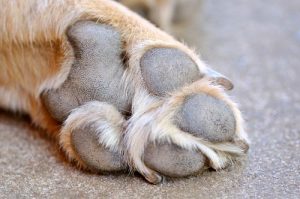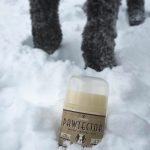With all the snow, ice, salt on the sidewalk, and generally chilly weather during the winter, your dog’s paws can suffer. Since they don’t have the same protection that we do when we wear shoes, it’s crucial to protect their paw pads. Thankfully, there are a number of strategies to guard your dog’s paws this winter. Be sure to take the following steps to get ready for the cold weather:
Whether you like them or not, booties are a practical way to keep your dog’s paws warm during the winter. Because not every breed is bred to withstand cold weather, booties are a practical way to safeguard your dog’s paws because they provide warmth, complete coverage, and are strong. Measure your dog’s foot from the heel to the tip of the toenail to determine its proper size. If you’re unsure about which styles to purchase, try some of our top choices.
Paw Balm: Apply some paw balm to your dog’s palms before letting them walk on snow or ice. This will lessen the dry skin and harm that salt can do. Make sure to reapply the balm after returning from walks. Keeping paw balm on hand will help keep their paws supple and soft during the chilly months. You can buy it at pet stores or make your own using our easy recipe for paw balm.
Keep a Towel on Hand: After walking your dog, make sure to wipe off their paws. This will lessen any damage caused by any salt, ice, or other debris that he may have stepped on while out for a walk. Consider dipping each paw in a bucket of lukewarm water and drying them with a towel if you are worried about salt.
Keep Walks Brief: For your dog’s safety during the bitter cold, keep walks brief. Long periods of exposure to the cold are risky and can result in frostbite. Remember that if it’s too cold for you, it probably is for your dog as well. You might want to think about putting your dog in a coat or jacket if you do take them for a walk. https://www. akc. org/wp-admin/admin-ajax. php Get Your Free AKC eBook.
AKC participates in affiliate advertising programs that give websites a way to monetize their content by promoting and linking to akc. org. If you buy something after reading this article, we might get a cut of the sale.
Dry, Chapped, Flaky, Irritated Paw Pads From Walking On Snow
 Dog paws may become dry, chapped, itchy, flaky and downright painful due to walking directly on cold snow. Imagine walking barefoot in the snow, your feet would start to suffer the consequences too.
Dog paws may become dry, chapped, itchy, flaky and downright painful due to walking directly on cold snow. Imagine walking barefoot in the snow, your feet would start to suffer the consequences too.
There are a number of products on the market geared at protecting your dog’s sensitive paw pads from the snow, such as dog boots. The thing is, not all dogs want to actually wear these boots and it can be a bit of a pain putting them on every time you go out for a walk.
A less invasive method of creating a barrier between your dog’s paws and the snow is provided by PawTection. The natural balm is simple to use and glides over your dog’s paws to create a barrier against the uncomfortable snow. Additionally, it has a ton of moisturizing qualities to fight the seasonal skin dryness.
If the skin on your dog’s paws is already dry, chapped, inflamed, or bleeding, you need something to replenish moisture and repair the skin. Paw Soother, an all-natural, vegan product, achieves this goal with the help of its calming, anti-inflammatory, and moisturizing properties.
De-icers are frequently used to help melt and remove snow from sidewalks, driveways, and roadways. Every winter, one of the biggest dangers to your dog is the chemicals in deicers. If your dog licks the chemicals off of their paws after using deicers, it could get sick or burn their paws.
PawTection provides a natural barrier against the elements, including deicers. Before going outside, apply PawTection to help reduce the risk of chemical burns or other damages brought on by de-icers.
Keep a bowl of water and a fresh rag at your door so you can clean your dog’s paws before you enter the house again. This will assist in removing any deicing residue that your dog might otherwise accidentally ingest and become dangerously ill.
Boots are the best way to protect your dog’s paws
Dog boots protect your four-legged best friend’s feet just like human winter boots do. They reduce their exposure to corrosive salt or chemicals and keep snow, ice, salt, or sand from getting stuck between their toes.
Although boots are the safest choice, it might take some time for your dog to get used to them. Giving your dog a tasty treat after you put on their boots helps them associate the boots with good things. Start by allowing them to walk around the house or yard while wearing boots, and be sure to reward with dog treats as you go. Good things are going to happen when the boots are on!
Only use boots that properly fit your dog. When your dog walks or runs, properly fitting boots keep them in place without being too tight to alter their natural gait.
Step 2: Apply Pressure To Stop Bleeding
The next step is to stop the bleeding after the wound has been cleaned. Apply gentle pressure to the wound with a clean towel if the bleeding hasn’t already stopped. Within a few minutes, the blood should start clotting. Go to the veterinarian right away, though, if the paw bleeding doesn’t stop in 10 to 15 minutes.
FAQ
Why do my dogs feet bleed in the snow?
Frostbite & Hypothermia. Your dog runs the risk of hypothermia and frostbite if it spends a lot of time outside in the winter. Your dog probably has some degree of frostbite if its paws are painful, red, or bleeding.
Are dogs paws okay in the snow?
Your dog’s health can be at risk from the winter weather, especially their paws. Your dog’s risk of frostbite increases with snow and ice, which also dries out their paw pads and causes chapped or cracked skin. The same as our chapped lips, cracked paws can be a pain.
Why are my dogs paws cracked and bleeding?
Wear and tear is possibly one of the most typical reasons for cracked paws. Ice melt and floor cleaners contain harsh chemicals that can irritate and crack your dog’s paws, warns Dr. Ryan. “Also, walking on hot pavement can result in paw blisters, and rocky, uneven terrain can result in cuts on the pads.” ”.
Why is my dog licking her paws until they bleed?
Your dog may be secretly licking or chewing their paws if they still exhibit signs of bleeding or soreness as a result of stress. When you’re not around, it’s common for dogs who suffer from separation anxiety to bite their paws out of anxiety or stress about being left alone.